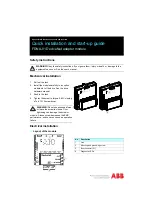
4/11
Quick Start Guide
Control I/O
To download the latest version of Studio Matrix Designer, the Windows application
that controls all Studio Matrix hardware, go to: www.airtoolsaudio.com
TM
Symetrix
Engineered by
5/11
Quick Start Guide
Control I/O
To download the latest version of Studio Matrix Designer, the Windows application
that controls all Studio Matrix hardware, go to: www.airtoolsaudio.com
TM
Symetrix
Engineered by
Relay Outputs
The Control I/O provides four (4) SPDT relay contacts. Common, Normally Closed and Normally Open pins are furnished on
Euroblock connectors. Contact ratings for the relays are: 3A, 24VDC, resistive; 0.3A, 60VDC, resistive.
Do not use at 120 VAC.
(Please see the Studio Matrix Designer online help for information on how to address a Relay Output in a Studio Matrix DSP
design.)
Remote ARCs
The four (4) REMOTE ARC ports distribute power and RS-485 data to one or more ARCs arranged in one or more chains over
standard CAT-5 cable. The Control I/O can support up to eight (8) ARCs total within the guidelines set forth in the
ARC Network
Design
section. (Please see the Studio Matrix Designer online help for information on how to program the ARC.)
Warning!
The RJ-45 connectors labeled “REMOTE ARCs” are only for use with the ARC controllers. Do not plug these
connections into any SymLink, HomerLink or Ethernet connector or into an ARC-PS or even another Control I/O!
ARC Network Design
The ARC’s power requirements vary depending on the voltage supplied to it. At 15V DC, it uses approximately 115 mA, while at
6V DC it uses approximately 300 mA maximum. As the voltage goes from 15V DC to 6V DC, the current requirement increases
accordingly.
ARCs can be daisy-chained and fed power over this daisy-chain from the Control I/O. However, as the length of the cable
increases, so does the resistive line loss, which lowers the voltage available at each subsequent ARC. The actual power drain
on each output from the Control I/O can vary substantially depending on the number of ARCs and the distance each of them
is separated by. In order to assist with system design, Symetrix has available a Microsoft Excel spreadsheet that can help a
system designer determine power requirements based upon cable length, number of ARCs and the power supply to be used.
This spreadsheet can be downloaded from the SymNet Technical Support pages at:
http://www.symetrixaudio.com/SymNet_Web/index.htm
Relay Outputs, Remote ARCs, ARC Network Design
The following table gives some indication of cabling
limitations, based on DC power only (the table is not relevant
if only RS-485 is distributed via the Control I/O): minimum
stated distances assume 28 gauge CAT-5 cabling, maximum
stated distances assume 24 gauge CAT-5 cabling.
CABLE LENGTH LIMITATIONS FOR ARC DC POWER
OVER CAT-5 CABLE
Total cable length
(to end of chain)
Number of ARCs in 1 daisy
chain
224-640 ft.
4
276-792 ft.
3
350-1028 ft.
2
486-1396 ft.
1
If power is not distributed over CAT-5, the ARC’s RS-485 will
be limited to 1000 ft in a star network configuration and 4000
ft in a daisy-chain network configuration. Longer distances
may be possible using third party RS-485 extender products.
Connections
The RS-485 port on the back of any Ring Master Studio
Matrix hardware device at ADDR #1 should be connected
to the RS-485 port on the Control I/O using shielded twisted
pair cable wired in parallel. Then, CAT-5 cable should be
distributed amongst the ARCs in the system preferably in a
star configuration or in minimal daisy chains according to the
limitations outlined previously. Finally, power can be applied
to the Control I/O and programming may commence.
CAT-5 CABLE PINOUT FOR POWER AND RS-485 DISTRIBUTION
Pin # Function
1
Ground
2
Ground
3
Ground
4
RS-485 “A”
5
RS-485 “B”
6
Ground
7
Power
8
Power
WARNING:
When designing a system, one must be careful
not to double power any ARCs. If all pins on the CAT-5
connections are used, power can travel over the CAT-5 cable
and reach any ARC on that particular chain. So, power over
CAT-5 could potentially come from the Control I/O or from an
ARC that is powered locally and then daisy chained via CAT-
5 to other ARCs. In general, it is recommended to use only
one type of connector on the ARCs, either the RJ-45s (with
CAT-5 cable) or the terminal blocks.
Summary of Contents for Airtools Control I/O
Page 10: ......





























